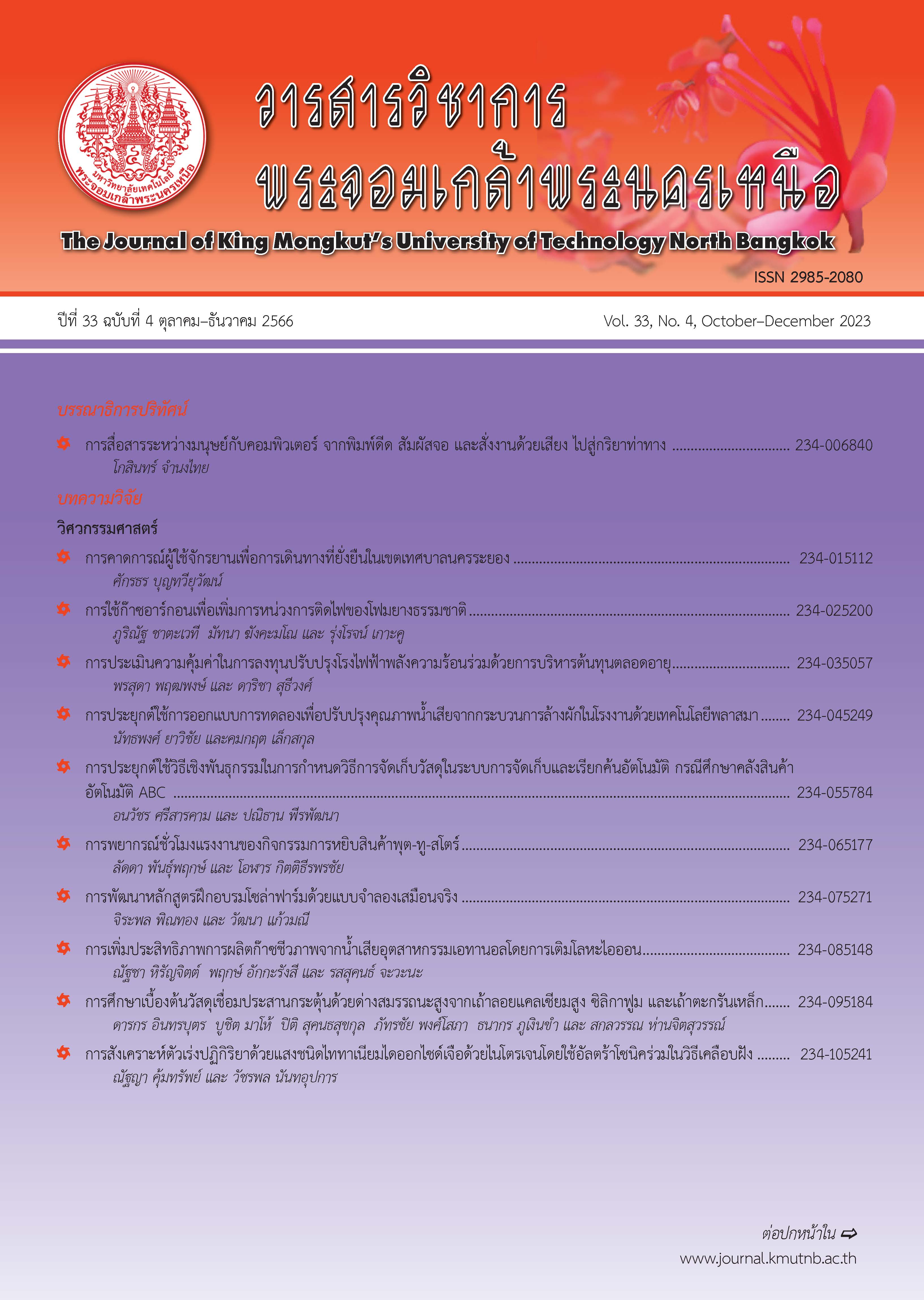การใช้ก๊าซอาร์กอนเพื่อเพิ่มการหน่วงการติดไฟของโฟมยางธรรมชาติ
Main Article Content
บทคัดย่อ
โฟมยางธรรมชาติสามารถนำไปประยุกต์ใช้เป็นผลิตภัณฑ์ต่างๆ ได้หลากหลาย เนื่องจากมีข้อดีหลายประการ เช่น กันกระแทกได้ดี เป็นฉนวนกันความร้อน และดูดซับเสียงได้ดี เป็นต้น แต่โฟมยางธรรมชาติยังมีข้อจำกัด คือ เป็นวัสดุที่ติดไฟได้ง่ายและลุกลามไฟได้อย่างรวดเร็ว งานวิจัยนี้จึงนำเสนอวิธีการปรับปรุงข้อจำกัดดังกล่าวของโฟมยางธรรมชาติ โดยการใช้ฟองอากาศ (AF) และฟองก๊าซอาร์กอน (ArF) ขนาดเล็ก ที่อัตราการไหลของก๊าซขาเข้าคงที่ 100 มิลลิลิตรต่อนาที โดยกระบวนการบับบลิ่ง ลักษณะโครงสร้างทางจุลภาคและสมบัติการหน่วงไฟของโฟมยางที่ผลิตได้ถูกศึกษาโดยเปรียบเทียบกับหมอนยางพาราที่วางขายตามท้องตลาดซึ่งผลิตจากกระบวนการดันลอป (DF) โดยการใช้กล้องจุลทรรศน์อิเล็กตรอนแบบส่องกราด (SEM) และเครื่องทดสอบการลามไฟ (Flammability Tester; UL94) ตามลำดับ ผลการวิจัยพบว่า ArF หน่วงการลุกลามไฟได้ดีที่สุด และดีกว่า DF ถึง 2.5 เท่า ทั้งนี้เนื่องจากโครงสร้างทางจุลภาคที่แตกต่างกัน และผลจากการมีก๊าซอาร์กอนในโฟมยาง นอกจากนี้โฟมยางที่ผลิตจากกระบวนการบับบลิ่งมีความหนาแน่นมากกว่าโฟมยางที่ผลิตจากกระบวนการดันลอป
Article Details

อนุญาตภายใต้เงื่อนไข Creative Commons Attribution-NonCommercial-NoDerivatives 4.0 International License.
บทความที่ลงตีพิมพ์เป็นข้อคิดเห็นของผู้เขียนเท่านั้น
ผู้เขียนจะต้องเป็นผู้รับผิดชอบต่อผลทางกฎหมายใดๆ ที่อาจเกิดขึ้นจากบทความนั้น
เอกสารอ้างอิง
V. Thongrueng, C. Dechwayukul, J. Soontho, and Y. Rukkachatsuwan, “Development of natural rubber foam processing,” Department of Mechanical Engineering, Faculty of Songkla University Hatyai, Songkla, Rep. RDG4650053, Mar. 2004 (in Thai).
S. Phomrak, A. Nimpaiboon, B. M. Z. Newby, and M. Phisalaphong, “Natural rubber latex foam reinforced with micro-and nanofibrillated cellulose via dunlop method,” Polymers (Basel), vol. 12, no. 9, pp. 1–16, 2020.
L. Wan, C. Deng, Z. Y. Zhao, H. Chen, and Y. Z. Wang, “Flame retardation of natural rubber: Strategy and recent progress,” Polymers (Basel), vol. 12, no. 2, pp. 1–25, 2020.
A. R. R. Menon, “Flame-retardant characteristics of natural rubber modified with a bromo derivative of phosphorylated cashew nut shell liquid,” Journal of Fire Sciences, vol. 15, no. 1, pp. 3–13, 1997.
S. D. Shaw, A. Blum, R. Weber, K. Kannan, D. Rich, D. Lucas, C. P. Koshland, D. Dobraca, S. Hanson, and L. S. Birnbaum, “Halogenated flame retardants: Do the fire safety benefits justify the risks?,” Reviews on Environmental Health, vol. 25, no. 4, pp. 261–305, 2010.
Y. H. Kim, M. Lee, I. J. Hwang, and Y. J. Kim, “Noise reduction of an extinguishing nozzle using the response surface method,” Energies, vol. 12, no. 22, pp. 1–13, 2019.
S. Sirikulchaikij, R. Kokoo, and M. Khangkhamano, “Natural rubber latex foam production using air microbubbles: Microstructure and physical properties,” Materials Letters, vol. 260, no. 1, pp. 126916, 2019.
Z. Xiao, T. Bin Aftab, and D. Li, “Applications of micro–nano bubble technology in environmental pollution control,” Micro & Nano Letters, vol. 14, no. 7, pp. 782–787, 2019.
M. Zhang, L. Qiu, and G. Liu, “Basic characteristics and application of micro-nano bubbles in water treatment,” presented at the IOP Conference Series: Earth and Environmental Science, 2020.
A. Agarwal, W. J. Ng, and Y. Liu, “Principle and applications of microbubble and nanobubble technology for water treatment,” Chemosphere, vol. 84, no. 9, pp. 1175–1180, 2011.
T. Parivatphun, S. Sangkert, J. Meesane, R. Kokoo, and M. Khangkhamano, “Constructed microbubble porous scaffolds of polyvinyl alcohol for subchondral bone formation for osteoarthritis surgery,” Biomedical Materials, vol. 15, no. 5, pp. 1–13, 2020.
W. Harnnarongchai and K. Chaochanchaikul, “Effect of blowing agent on cell morphology and acoustic absorption of natural rubber foam,” Applied Mechanics and Materials, vol. 804, no. 1, pp. 25–29, 2015.
K. Hecht, O. Bey, J. Ettmüller, P. Graefen, R. Friehmelt, and M. Nilles, “Effect of gas density on gas holdup in bubble columns,” Chemie Ingenieur Technik, vol. 87, no. 6, pp. 762–772, 2015.
D. P. Gatley, S. Herrmann, and H. J. Kretzschmar, “A Twenty-First century molar mass for dry air,” HVAC&R Research, vol. 14, no. 5, pp. 655–662, 2008.
I. G. Reilly, D. S. Scott, T. J. W. Debruijn, and D. Macintyre, “The role of gas phase momentum in determining gas holdup and hydrodynamic flow regimes in bubble column operations,” The Canadian Journal of Chemical Engineering, vol. 72, no. 1, pp. 3–12, 1994.
A. A. Kulkarni and J. B. Joshi, “Bubble formation and bubble rise velocity in gas-liquid systems: A review,” Industrial & Engineering Chemistry Research, vol. 44, no. 16, pp. 5873–5931, 2005.
D. Ma, M. Liu, Y. Zu, and C. Tang, “Two-dimensional volume of fluid simulation studies on single bubble formation and dynamics in bubble columns,” Chemical Engineering Science, vol. 72, pp. 61–77, 2012.
C. Schick, “Differential scanning calorimetry (DSC) of semicrystalline polymers,” Analytical and Bioanalytical Chemistry, vol. 395, no. November 2009, pp. 1589–1611, 2014.
J. Johns and V. Rao, “Thermal stability, morphology, and X-ray diffraction studies of dynamically vulcanized natural rubber/ chitosan blends,” Journal of Materials Science, vol. 44, no. 15, pp. 4087–4094, 2009.
M. L. Kralevich and J. L. Koenig, “FTIR analysis of silica-filled natural rubber,” Rubber Chemistry and Technology, vol. 71, no. 2, pp. 300–309, 1998.
S. Suethao, W. Ponloa, S. Phongphanphanee, J. Wong-Ekkabut, and W. Smitthipong, “Current challenges in thermodynamic aspects of rubber foam,” Scientific Reports, vol. 11, no. 1, pp. 1–12, 2021.
S. Suethao, S. Phongphanphanee, J. Wong- Ekkabut, and W. Smitthipong, “The relationship between the morphology and elasticity of natural rubber foam based on the concentration of the chemical blowing agent,” Polymers (Basel), vol. 13, no. 7, 2021.

